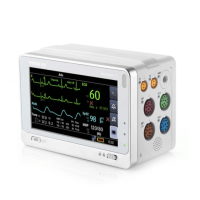7
T1 Quick Reference Guide
of BP (systolic and diastolic) while too large a cuff results in the
underestimation of BP. Errors in the 10 to 40 mmHg range can occur.
Ensure that the cuff is wrapped directly over the patient’s skin. BP
measurement could be 10 to 40 mmHg higher or lower than actual when the
cuff is applied over clothing.
• Thecuffshouldbeappliedsothatthecenterofthebladderinthecuff
is over the brachial artery. Use the reference marker for this.
• Forbestresults,thecuffshouldbeplacedonthearmatheartlevel
and the lower arm supported passively. Published data indicates that
BP can increase about 2 mmHg for every inch that the cuff is below
heart level and decrease by the same amount if above heart level.
• Avoidcompressionorrestrictionofthepressurehose.Donotplace
the NIBP cuff on a limb that is being utilized for any other medical
procedure, for example, an I.V. catheter.
• HavethepatientsitquietlyforseveralminutesbeforeBP
measurement and remain still during measurement to avoid
unnecessary motion artifact. If the patient has not rested before
measurement, BP could be elevated by 10 to 20 mmHg.
• DonottalktothepatientduringBPmeasurementastalkinghasbeen
shown to result in a 10 to 15 mmHg overestimation of BP.
• Thepatient’sbackandfeetshouldbeproperlysupportedwiththe
legs kept uncrossed. Unsupported back and feet could increase BP
by up to 15 mmHg, while crossed legs could result in a 4 to 12 mmHg
increase.
• Otherfactorsthathavebeenshowntoresultinanoverestimationof
BP are labored breathing (5 to 8 mmHg), full bladder (10 to 15 mmHg),
pain (10 to 30 mmHg).
Guidance Table
Cuff Description Limb Circumference
Child 10 - 19 cm
Small Adult 18 - 26 cm
Adult 25 - 35 cm
Large Adult 33 - 47 cm

